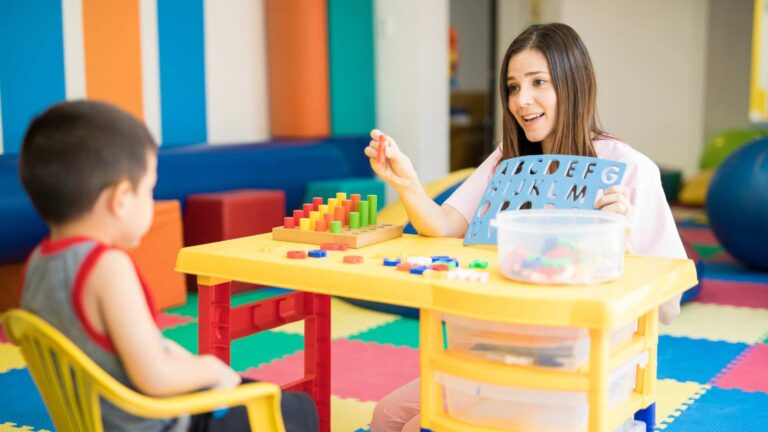Tabla de contenidos
¿Cómo puede el momentum conductual ayudar a mi hijo con autismo?
El momentum conductual juega un papel crucial en la terapia ABA, especialmente para los niños y adolescentes con trastorno del espectro autista (TEA). Implica aumentar gradualmente el impulso hacia el logro de los comportamientos o metas deseadas , comenzando con pasos pequeños y alcanzables. La aplicación del momentum conductual puede hacer que las sesiones de terapia ABA sean más gratificantes y aumenten la motivación, ya que el enfoque se basa en la idea de que es más probable que las personas adopten una conducta si han tenido éxito antes de llevarla a cabo.
Y si te estás preguntando: "¿Cómo puede el momentum conductual ayudar a mi hijo con autismo?" Bueno, incorporar estrategias basadas en el momentum conductual puede ser beneficioso de varias maneras. Puede ayudar a tu hijo con TEA al desarrollar gradualmente su confianza, cooperación y capacidad para manejar los cambios. Al comenzar con tareas que les resultan fáciles y aumentar progresivamente la dificultad, puede crear un impulso positivo de éxito que les facilite aprender nuevas habilidades, cumplir con las solicitudes y adaptarse a diferentes situaciones.
En ABA Centers of Florida, nos enfocamos en aplicar métodos comprobados para fomentar comportamientos positivos y nuevas habilidades en niños con TEA. Además, ofrecemos estrategias para mejorar el compromiso y la motivación a lo largo del proceso de terapia.
Teoría del Momentum Conductual
El estudio Integrative Model for the Study of Behavioral Momentum explora cómo el impulso conductual, que es la persistencia del comportamiento a pesar de los cambios en el entorno, está influenciado por factores como la tasa de respuesta y la resistencia al cambio. Los investigadores analizaron datos de experimentos con palomas para entender cómo interactúan estos factores en diferentes configuraciones experimentales. Descubrieron que, en procedimientos con una única opción, la resistencia al cambio en los diferentes componentes del programa dependía de la proporción de las tasas de refuerzo asociadas con esos componentes.
En dos procedimientos esenciales, los investigadores vincularon la resistencia al cambio en componentes equivalentes con la proporción de las tasas de refuerzo asociadas a puntos críticos. Introdujeron un modelo que considera tanto las tasas de refuerzo en los componentes del programa en diversos puntos clave, como las tasas de refuerzo vinculadas a puntos críticos a través de los componentes. El estudio enfatiza que una comprensión completa del impulso conductual requiere considerar tanto la ley relativa del efecto para múltiples programas como las contingencias específicas relacionadas con puntos cruciales y componentes del programa.
Momentum Conductual en la Terapia ABA
En la terapia ABA, este concepto ayuda a las personas a mantener un comportamiento positivo en situaciones en las que puede haber distracciones o tentaciones de participar en comportamientos menos deseables.
Así es como funciona:
Solicitudes de alta probabilidad (HRPS, por sus siglas en inglés): El impulso conductual a menudo comienza con una serie de tareas o solicitudes fáciles de completar, conocidas como solicitudes de alta probabilidad. Estas tareas son las que es muy probable que el individuo cumpla. Al completar estas tareas, el individuo construye un impulso de comportamiento positivo.
Transición a tareas de baja probabilidad: Después de completar el HRPS, el terapeuta pasa a la conducta o tarea objetivo, que puede ser más difícil o menos preferida por el individuo. Debido al impulso acumulado al completar las tareas anteriores, es más probable que el individuo cumpla con el comportamiento objetivo.
Refuerzo El refuerzo positivo juega un papel fundamental en este proceso. Cada tarea completada, independientemente de su probabilidad de éxito, se encuentra con un refuerzo en forma de elogios y acceso a objetos o actividades preferidas. El refuerzo positivo aumenta la probabilidad de repetir la conducta en el futuro.
Mantener el impulso: Una vez que el individuo se involucra en el comportamiento objetivo, es esencial mantener el impulso proporcionando refuerzo y apoyo continuos. Esta consistencia ayuda a solidificar el comportamiento y aumenta la probabilidad de que se repita en situaciones similares.
Generalización: Con el tiempo, el objetivo es que el individuo generalice el comportamiento objetivo a varios entornos y situaciones, incluso cuando la secuencia inicial de alta probabilidad no está presente. Esta generalización indica que el cambio de comportamiento se ha vuelto más arraigado y adaptativo.
Por ejemplo, durante la sesión de terapia, el terapeuta puede iniciar el HRPS pidiéndole al niño que participe en actividades que disfrute, como jugar con su juguete favorito o aplaudir. Después de completar estas tareas y construir un impulso positivo de cumplimiento, el terapeuta pasa a un comportamiento más desafiante, como hacer contacto visual o seguir una instrucción simple. Debido al impulso establecido de las tareas anteriores y al refuerzo positivo proporcionado, es más probable que el niño se involucre en el comportamiento objetivo.
Este enfoque estructurado ayuda al niño a generalizar los comportamientos deseados más allá de la sesión de terapia, lo que lleva a mejorar las interacciones sociales y las habilidades de adaptación en varios entornos.
Beneficios del Momentum Conductual en la Terapia ABA
La incorporación del momentum conductual en las sesiones de terapia ABA ofrece beneficios significativos para el plan estructurado y los objetivos. Este enfoque metodológico proporciona un marco que fomenta resultados positivos.

El impulso conductual ayuda a generar confianza en las personas con TEA al permitirles incrementar el éxito. Comenzar las sesiones de terapia con tareas fáciles de alcanzar establece una sensación de logro, aumentando la creencia en la capacidad de uno para abordar objetivos cada vez más desafiantes.
Además, la implementación de estrategias de momentum conductual mejora la cooperación dentro de los entornos terapéuticos. A medida que las personas experimentan el éxito y se dan cuenta de la viabilidad de las metas establecidas, su disposición a participar en actividades terapéuticas crece, lo que lleva a sesiones más productivas y relaciones terapéuticas más sólidas.
terapia ABA consiste en dividir los objetivos más grandes en pasos pequeños y manejables, promoviendo tasas más altas de finalización de tareas. Al guiar gradualmente a las personas desde tareas más sencillas hasta comportamientos más complejos, los terapeutas de ABA facilitan el compromiso y el logro sostenidos a través de un proceso estructurado.
Además, el refuerzo positivo constante refuerza la motivación y mantiene el impulso durante las sesiones de terapia. Al vincular la finalización exitosa de la tarea con recompensas y elogios, los terapeutas mejoran el compromiso y apoyan un cambio de comportamiento que sea más duradero.
Desafíos al Aplicar el Impulso Conductual
El empleo del momentum conductual puede mejorar significativamente la promoción de comportamientos positivos en diversos entornos. Sin embargo, el Journal of the Experimental Analysis of Behavior destaca varios obstáculos comunes que se enfrentan durante la fase de implementación de las estrategias de impulso conductual. Entre estos desafíos, garantizar la coherencia se destaca como una preocupación principal. Enfatiza la necesidad de un refuerzo continuo y uniformidad en la introducción y refuerzo de nuevos comportamientos, destacando la importancia de los esfuerzos colaborativos entre cuidadores y profesionales.
Además, la elaboración de una estrategia que sea alcanzable y práctica para integrar el momentum conductual implica seleccionar cuidadosamente los incentivos adecuados y el establecer los mecanismos de rendición de cuentas. A pesar de estos obstáculos, aplicar exitosamente esta intervención en la modificación de la conducta subraya el impacto transformador que se puede lograr a través de una planificación exhaustiva y un compromiso inquebrantable.
ABA Centers of Florida y la Terapia de Primer Nivel
Momentum conductual es un pilar fundamental de la terapia ABA, ya que ofrece una vía poderosa para lograr un cambio conductual positivo y duradero. A través de una profunda comprensión de sus componentes y la aplicación hábil en la práctica clínica, nuestros terapeutas pueden desbloquear el potencial y las habilidades de los niños en el espectro.
En ABA Centers of Florida, brindamos a las familias en Doral, Miramar, Jensen Beach, Tampa, Orlando, Boca Ratón y más áreas del Estado del Sol la seguridad de implementar programas científicamente probados, altamente efectivos y orientados a resultados que ayudan a mejorar la vida de los niños con autismo.
Nuestros empáticos terapeutas crean un ambiente seguro y acogedor para nuestros clientes y sus familias. Ya sea que reciban terapia en nuestros centros con salas sensoriales y áreas de juego adaptadas o elijan la comodidad de sus hogares para las sesiones de terapia, nuestro equipo altamente capacitado y dedicado se asegura de que tu hijo reciba la atención personalizada que necesita.
Llámanos al (772) 773-1975 o comparte tus datos de contacto en el formulario, y nuestro equipo especializado se comunicará contigo para verificar tus opciones de seguro y explicarte los diferentes servicios que tenemos disponibles para el cuidado del autismo.








